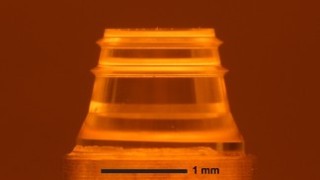Aug 7 2015
EPFL scientists have developed a new method for counting the cycles of light waves, which can be used in a multitude of applications.
 An optical microresonator ©Tobias Kippenberg/EPFL
An optical microresonator ©Tobias Kippenberg/EPFL
Measuring the frequency, or color, of light waves is central to technologies ranging from healthcare to astronomy. However, light waves oscillate hundreds of trillions of times per second, a frequency that is impossible to measure directly. Instead, it requires complex laboratory equipment, which match unknown frequencies of light waves to known frequencies of radio waves or microwaves. EPFL scientists have now been able to precisely measure light wave frequencies by using a tiny device known as an optical microresonator. The method does away with conventional lab setups and can open the way for new technologies. The work is published in the journal Optica.
The lab of Tobias J. Kippenberg at EPFL, led by Tobias Herr and John D. Jost created what is called an “optical frequency comb”. This is essentially a series of densely-spaced spectral lines whose spacings are identical and known. The equidistant lines represent colors of light, each color corresponding to a specific, known frequency.
Because they are so well defined, optical frequency combs can be used as a “ruler” for measuring the unknown frequency – or color – of a light beam, e.g. from a laser. By comparing the unknown color to this ruler, it is possible to calculate the corresponding frequency.
Although optical frequency combs earned their inventors the Nobel prize in Physics in 2005, they still required large optical setups. But in 2007 Kippenberg’s lab showed that optical frequency combs could be created using tiny devices called “optical microresonators”. These are structures a few millimeters to a few tens of microns in diameter that can trap incoming light and convert it into an optical frequency comb.
In the method that the EPFL researchers demonstrated, light from a laser is trapped inside an optical microresonator. Because of the special nonlinear properties of the device, an ultra-short pulse is formed inside, travelling around the microresonator 14 billion times per second. This pulse forms the optical frequency comb.
The scientists used a part of the ultra-fast pulse from the resonator for self-referencing, a method that exactly determines the frequencies of each individual color of the generated frequency comb. With this, the researchers could prove that their optical frequency comb can be used for the most precise measurement applications.
Until now, it has been unclear whether or not optical frequency combs generated in this way could be used for precision frequency measurements just as conventional methods. “Our study shows for the first time that this is indeed the case,” says John Jost. “This means there are no fundamental barriers left for this microresonator optical frequency comb technology, which can be used in new applications such as telecommunications, astronomy, medical devices, and others.”
This work was supported by a Marie Curie International Incoming Fellowship and Intra-European Fellowship, the Swiss National Science Foundation, the European Space Agency, the Eurostars program, and the Defense Advanced Research Program Agency PULSE program.
Reference
Jost JD, Herr T, Lecaplain C, Brasch C, Pfeiffer MHP, Kippenberg TJ. Counting the Cycles of Light using a Self-Referenced Optical Microresonator. Optica 04 August 2015. DOI: http://dx.doi.org/10.1364/OPTICA.2.000706
Author: Nik Papageorgiou
Source: SB | Basic Sciences